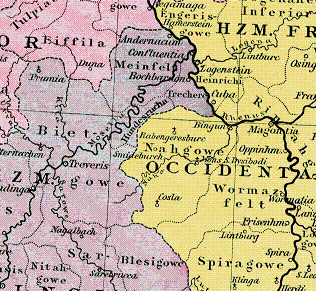Speyergau on:
[Wikipedia]
[Google]
[Amazon]
 Speyergau was a medieval
Speyergau was a medieval
 Speyergau was a medieval
Speyergau was a medieval county
A county is a geographic region of a country used for administrative or other purposes Chambers Dictionary, L. Brookes (ed.), 2005, Chambers Harrap Publishers Ltd, Edinburgh in certain modern nations. The term is derived from the Old French ...
in the East Frankish ( German) stem duchy of Franconia
Franconia (german: Franken, ; Franconian dialect: ''Franggn'' ; bar, Frankn) is a region of Germany, characterised by its culture and Franconian dialect (German: ''Fränkisch'').
The three administrative regions of Lower, Middle and Upper F ...
. It was centred around the administrative centre of Speyer
Speyer (, older spelling ''Speier'', French: ''Spire,'' historical English: ''Spires''; pfl, Schbaija) is a city in Rhineland-Palatinate in Germany with approximately 50,000 inhabitants. Located on the left bank of the river Rhine, Speyer li ...
and roughly covered the former Roman administrative area of Civitas Nemetum, which is today the south-eastern portion of the Palatinate
Palatinate or county palatine may refer to:
*the territory or jurisdiction of a count palatine
United Kingdom and Ireland
*County palatine in England and Ireland
* Palatinate (award), student sporting award of Durham University
*Palatinate (col ...
region between the Rhine
The Rhine ; french: Rhin ; nl, Rijn ; wa, Rén ; li, Rien; rm, label=Sursilvan, Rein, rm, label=Sutsilvan and Surmiran, Ragn, rm, label=Rumantsch Grischun, Vallader and Puter, Rain; it, Reno ; gsw, Rhi(n), including in Alsatian dialect, Al ...
river, the Palatinate Forest range, and some smaller parts of northern Alsace
Alsace (, ; ; Low Alemannic German/ gsw-FR, Elsàss ; german: Elsass ; la, Alsatia) is a cultural region and a territorial collectivity in eastern France, on the west bank of the upper Rhine next to Germany and Switzerland. In 2020, it ha ...
. The Speyergau, together with the neighbouring Wormsgau and Nahegau, was part of the major possessions held by the Salian dynasty
The Salian dynasty or Salic dynasty (german: Salier) was a dynasty in the High Middle Ages. The dynasty provided four kings of Germany (1024–1125), all of whom went on to be crowned Holy Roman emperors (1027–1125).
After the death of the ...
of German kings and Holy Roman Emperors.Geschichte der Stadt Speyer, Vol. 1, 1982, Kohlhammer Verlag, Stuttgart,
Counts of Speyergau
Some renowned counts of Speyergau were: # Werner V (c. 899 - c. 935), the first definite progenitor of the Salian Dynasty, also count of Nahegau and Wormsgau, member of the house ofConradines
The Conradines or Conradiner were a dynasty of Franconian counts and dukes in the 8th to 11th Century, named after Duke Conrad the Elder and his son King Conrad I of Germany.
History
The family is first mentioned in 832, with Count Gebhard in ...
.
# Conrad the Red (X 955), son of Werner V, also count of Nahegau, Wormsgau and Niddagau, count in Franconia, duke
Duke is a male title either of a monarch ruling over a duchy, or of a member of Royal family, royalty, or nobility. As rulers, dukes are ranked below emperors, kings, grand princes, grand dukes, and sovereign princes. As royalty or nobility, t ...
of Lorraine
Lorraine , also , , ; Lorrain: ''Louréne''; Lorraine Franconian: ''Lottringe''; german: Lothringen ; lb, Loutrengen; nl, Lotharingen is a cultural and historical region in Northeastern France, now located in the administrative region of G ...
, ∞ around 947 Liutgard of Saxony
Saxony (german: Sachsen ; Upper Saxon: ''Saggsn''; hsb, Sakska), officially the Free State of Saxony (german: Freistaat Sachsen, links=no ; Upper Saxon: ''Freischdaad Saggsn''; hsb, Swobodny stat Sakska, links=no), is a landlocked state of ...
(born 931, died 953), daughter of Otto I, Holy Roman Emperor
Otto I (23 November 912 – 7 May 973), traditionally known as Otto the Great (german: Otto der Große, it, Ottone il Grande), was East Francia, East Frankish king from 936 and Holy Roman Emperor from 962 until his death in 973. He was the olde ...
#Otto
Otto is a masculine German given name and a surname. It originates as an Old High German short form (variants ''Audo'', '' Odo'', '' Udo'') of Germanic names beginning in ''aud-'', an element meaning "wealth, prosperity".
The name is recorde ...
of Worms (died 1004), only son of Conrad the Red, also count of Nahegau, Wormsgau, Elsenzgau, Kraichgau, Enggau, Pfinzgau and Ufgau, duke of Carinthia
# Conrad II the younger, (born probably 1003, died 1039), grandson of Otto I, also count of Nahegau, Wormsgau, duke of Carinthia (1036-1039)
Rural reeves (Landvogt) of Speyergau
* Georg I. von Geroldseck, count of Veldenz, 1310/15 * Otto V. von Ochsenstein, died 1327, 1291/1302 Landvogt ofOrtenau
The Ortenau, originally called Mortenau, is a historic region in the present-day German state of Baden-Württemberg. It is located on the right bank of the river Rhine, stretching from the Upper Rhine Plain to the foothill zone of the Black Fo ...
, 1315/27 Landvogt of Alsace, 1318 Landvogt of Speyergau
* Otto VI. von Ochsenstein, Landvogt of Alsace and Speyergau, died before 1377
References